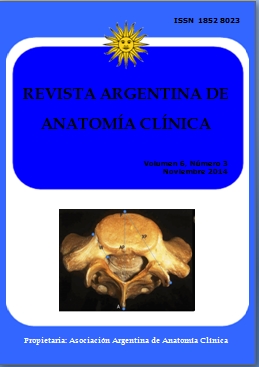MORPHOLOGY AND MORPHOMETRY OF DRY ADULT ACETABULA IN NIGERIA. Morfología y morfometría de los acetábulos adultos secos en Nigeria
DOI:
https://doi.org/10.31051/1852.8023.v6.n3.14139Palabras clave:
Acetabulum, prothesis, congenital hip dysplasia, acetabular diameter, acetabular depth, Acetábulo, prótesis, displasia congénita de la cadera, diámetro acetabular, profundidad acetabularResumen
Objectives: The present study was undertaken to measure the acetabular depth and diameter, to determine the shape of the anterior acetabular ridge and to find out the relationship between the depth and diameter which will be useful in preparing suitable sizes of prosthesis for Nigerians. Materials and Method: 100 dry adult hip bones of unknown gender but known sides were used. A vernier caliper and ruler were used for the measurement. The shapes of the anterior acetabular ridge were noted, and the transverse and superoinferior diameters of the acetabulum were measured using vernier calipers. The data were recorded and analyzed using SPSS. Result: The result showed that there were four major shapes which are: curved (35%), angular (33%), straight (23%) and irregular (9%). The total diameter on the right side was slightly less than the left. There was a significant positive relationship between the depth and the transverse, superoinferior and total diameters (p < 0.05). Conclusion: These relationships should be borne in mind when providing prostheses for Nigerians, during hip arthroplasty, treatment of hip joint fractures and in diagnosing congenital hip dysplasia.Referencias
Aksu FT, Ceri NG, Arman C, Tetik S. 2006. Morphology and morphometry of the acetab-ulum. DEÜ Tip Fakültesi Dergisi 20: 143-48.
Aktas S, Pekindil G, Ercan S, Pekindil Y. 2000. Acetabular Dysplasia in normal Turkish adults. Bull Hosp Jt Dis 59: 158-62.
Chauhan R, Paul S, Dhaon BK. 2002. Anatomical Parameters of North Indian Hip joints – Cadaveric Study. Journal of Anatomical Society of India 51: 39-42.
Gaurang P, Srushti R, Patel SV, Patel SM, Nishita J. 2013. Morphology and morphometry of acetabulum. International Journal of Biolog-ical and Medical Research 4: 2924-26.
Govsa F, Ozer MA, Ozgur Z. 2005. Morphologic features of the acetabulum. Arch Orthop Trauma Surg 125: 453-61.
Jeremi? D, Jovanovi? B, Živanovi?-Ma?uži? I, ?or?evi? G, Sazdanovi? M, ?or?evi? M, Sazdanovi? P, Vulovi? M, Toševski J. 2011. Sex dimorphism of postural parameters of the human acetabulum. Arch. Biol. Sci 63: 137-43.
Maruyama M, Feinberg JR, Capello WN, D’antonio JA. 2001. Morphologic features of the acetabulum and femur: anteversion angle and implant positioning. Clin Orthop 1: 52-65.
Moore KL, Dalley AF, Agur AM. 2010. Pelvis and Perineum: Clinically Oriented Anatomy, 6th Edition, Philadelphia, Lippincott Williams and Wilkins, 328.
Sinnatamby CS. 2006. Last’s Anatomy, Regional and Applied, 11th Edition, Edinburgh, Churchill Livingstone, 132.
Tannast M, Siebenrock KA, Anderson SE. 2007. Femoroacetabular Impingement: Radiographic Diagnosis - What the radiologist should know, AJR 188: 1540-52.
Vandenbussche E, Saffarini M, Taillieu F, Mutschler C. 2008. The Asymmetric Profile of the Acetabulum. Clin Orthop Relat Res 466: 417-23
Vyas K, Shroff B, Zanzrukiya K. 2013. Morphol-ogical aspect of acetabulum of hip bone. Int J Res Med 2: 78-82.
Descargas
Publicado
Número
Sección
Licencia
Los autores/as conservarán sus derechos de autor y garantizarán a la revista el derecho de primera publicación de su obra, el cuál estará simultáneamente sujeto a la Licencia de reconocimiento de Creative Commons que permite a terceros compartir la obra siempre que se indique su autor y su primera publicación en esta revista. Su utilización estará restringida a fines no comerciales.
Una vez aceptado el manuscrito para publicación, los autores deberán firmar la cesión de los derechos de impresión a la Asociación Argentina de Anatomía Clínica, a fin de poder editar, publicar y dar la mayor difusión al texto de la contribución.



